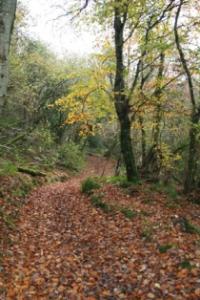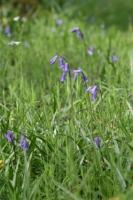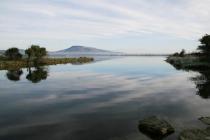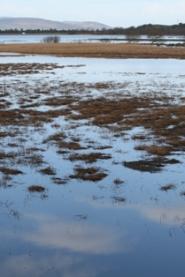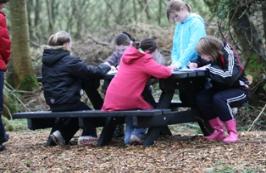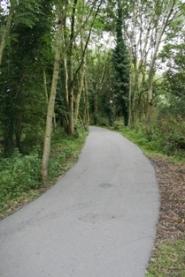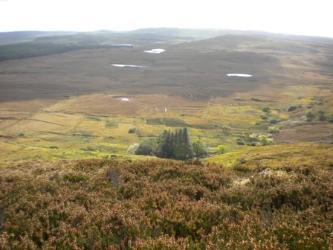Ardnamona Nature Reserve
Longitude: -8.071594
| Ardnamona Wood Nature Reserve is a fine oak woodland, some 46.6 hectares in size which lies approximately 5km north-east of Donegal Town, just west of Lough Eske. The site consists of old Oak woodland, a listed habitat on Annex I of the EU habitats Directives. The woodland is of scientific interest for its size, natural heritage, and flora. The wood displays habitats of dry areas dominated by Oak, and wet woodland with Alder. Ash, Rowan and Downy Birch also occur in the high canopy with Holly, Hazel, and Willow in the understorey. The site is also host to the Killarney Fern, a red data book species listed in Annex II of the Habitats Directive. Two other rare plants, Whorled Caraway and Six-stamened Waterworth, are also present. | Is talamh coille breá Tearmann Dúlra Choill Ard na Móna ar 46.6 heachtár atá suite thart fá 5 km siar ó thuaidh ó Bhaile Dhún na nGall agus siar díreach ó Loch Iascaigh. Séard atá sá láithreán ná talamh coille de Shean-Dair, gnáthóg atá liostaithe ar Aguisín 1 de Threoracha faoi Ghnáthóga an Comhaoontais Eorpach. Tá suim eolaíochta sa talamh coille seo de bharr a mhéid, a oidhreacht nádúrtha agus a fhásra. Tá áiteanna tirime lán le crainn Darach le feiceáil sa choill agus talamh coille fliuch le Fearnóg. Tá crainn Fuinseoige, Caorthainn, Beithe ann chombh maith i measc na gcrann ard agus futhu sin tá Cuileann, Coll agus Saileach. Tá Raithneach Chill Airne le fail ar an láithreán seo. Is gné de chuid leabhair dheirg sonraí í atá liostaithe in Aguisín II de Threor Gnáthóg. Ta dhá phlanda eile neamhchoitianta ann chomh maith Cearrbhas Fáinneach agus Luachuisce le sé staimín. |
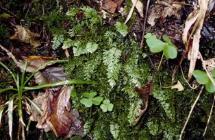
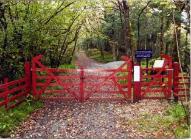
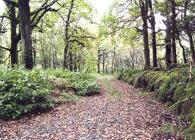
Removal of RhododendronRhododendron ponticum is a non-native invasive evergreen shrub that completely takes over from native flora. It was introduced into Ireland, in the early 1800’s, by landlords and estate owners to provide cover for game. Since then it has spread or been introduced to many parts of Ireland. We may all have noticed those “wonderful pink flowers” blooming across the hillsides of Ireland in May – June, little realising or understanding the grave damage they are causing. Rhododendron replaces the shrub layer in Oakwoods, blocking out most of the sunlights access to the woodland floor, making the woodland totally unsuitable for birds or other animals to live in. It also prevents oak seedlings from regenerating. Fortunately, Rhododendron has been almost completely removed from Ardnamona wood after years of cutting and spraying. |
Fáil réidh leis an RódaidéadránIs tor síorghlas neamhdhúchasach ionrach Rhododendron ponticum a chuireann ruaig iomlán ar an bhfásra dúchasach. Ag tús an naoú gcéad déag thug tiarnaí talon agus úinéirí eastát é isteach in Éirinn chun fasra a chur ar fail do éin seilge. Ó shin i Leith scaipeadh é nó tugadh isteach é I go leor áiteanna éagsúla ar fud na hÉireann. Is dócha gur thug muid uilig faoi deara na bláthanna bánghorma iontacha ag bláthú ar thaobhanna chnoc ar fud na hÉireann i mí na Bealtaine agus sa Mheitheamh ach níor thuig muid an dochar atá a dhéanamh acu. Glacann an Ródaidéadrán áit na sraithe tor sna Coillte darach. Ní ligeann sé isteach solas na gréine chuig urlár an talamh coille agus mar sin ní bhíonn sé foirstineach d’éin ná d’ainmhithe cónaí ann. Cuireann sé cosc athghiniúna ar shíológa darach chomh maith. Ar an dea-uair tá sé beagnach go hiomlán glanta as Ard na Móna I ndiaidh blianta a ghearradh agus a spraeáil. |
Visiting ArdnamonaIn 2005 a new circular path was constructed through the woodlands by the National Parks & Wildlife Service. This path begins just inside the main gate and veers off to the right. After about 2km the path rejoins the main avenue, which links back to the main entrance. Plants to look out for when visiting Ardnamona Wood are Wood Sage, Bluebell, Foxglove, Bugle, Wild Garlic, Wood Sorrel, Lesser Celandine, and Wood Anenome. In the nearby Lough Eske and River Eske, two very important Annex II species are present, namely the Freshwater Pearl Mussl (River Eske) and Artic Char (Lough Eske). Contact Carl Byrne on 087 – 6378398, National Parks & Wildlife Service Conservation Ranger, with any queries. |
Ar Cuairt leis an Ard na MónaI 2005 thóg an tSeirbhís Páirceanna Náisiúnta agus Fiadhúlra casán ciorclach tríd na tailte coille. Tosaíonn an casán seo taobh istigh den phríomh-gheata agus casann sé ar dheis. I ndiaidh timpeall 2 km sroicheann an casán an príomhbhealach a thugann an cuairteoir ar ais go dtí an príomh-bhealach isteach. Ba choir don chuairteoir na plandaí seo a leanas a thabhairt faoi deara: Sáiste Coille, Cloiginí Gorma, Lus, Buabhall, Gairleog Fhiáin, Samhadh Coille, Celandín Beag agus Anamóine Coille. Tá dhá ghné tábhachtacha de chuid Aguisín 2 le fail I Loch Iascaigh agus in abhainn Iascaigh atá in aice láimhe. Is iad an Diúilicín Péarla Fionnuisce (Abhainn Iascaigh) agus Ruabhreac Airtic (Loch Iascaigh). I gcas fiosrúcháin Teaghmháil Carl Byrne: 087 – 6378398, Maor, Seirbhís Pairceanna Náisiúnta agus Fiadhúlra. |
Ballyarr Wood Nature Reserve
Longitude: -7.71
|
Ballyarr Wood is a national Nature Reserve owned and managed by the National Parks & Wildlife Service. It has been designated as a Special Area of Conservation under the EU Habitats Directive because it is one of the best and largest examples of semi-natural deciduous woodland in the north-west of the country, and it forms an important link in Ireland’s network of woodland reserves. Old sessile oak woods with holly and hazel is a habitat listed in Annex I of the EU Habitats Directive. |
Is Anaclann Náisiúnta Dúlra í Coill Bhaile Áir atá faoi úinéireacht agus faoi bhainistíocht na Seirbhíse Páirceanna Náisiúnta & Fiadhúlra. Tá sí ainmnithe mar Limistéar Caomhantais Speisialta faoi Threoir maidir le Gnáthóga ón Aontas Eorpach mar go bhfuil sí ar cheann de na samplaí is fearr agus is mó de choill dhuillsilteach leathnádúrtha in iarthuaisceart na tíre agus tá sí ina nasc tábhachtach i ngréasán anaclanna coillearnaí na hÉireann. Tá gnáthóg de choillte le seanchrainn darach Gaelach agus cuileann agus coll liostaithe in Aguisín I de Threoir maidir le Gnáthóga ón Aontas Eorpach.
|
Old Oak WoodlandBallyarr Wood is predominantly old oak woodland. A number of other habitats including wet woodland, scrub, wet heath and wet grassland also occur. The oak woodland has a well developed structure, with a high canopy of well grown oaks, and a good understory of holly and hazel and rich ground flora. The woodland has responded well to recent management practices such as the exclusion of grazing livestock, and natural regeneration of trees is occurring, particularly of Oak, Rowan, Holly and Hazel. The other habitats, particularly the open areas of heath and wet grassland, enhance the diversity, value and character of the woodland. |
Seanchrainnte DarachSeanchrainnte darach is mó atá i gCoill Bhaile Áir. Bíonn roinnt gnáthóga eile, cosúil le coill fhliuch, grágán, fraochmhá fhliuch agus féarach fliuch, ann freisin. Tá struchtúr dea-fhorbartha ag an gcoill darach, le ceannbhrat ard de chrainn darach lánfhásta agus sraith mhaith mheánach de chuileann agus de choll, chomh maith le flóra saibhir ar an talamh. Ghlac an choill go maith le cleachtais bhainistíochta a cuireadh in áit le déanaí. I measc na gcleachtas sin coinníodh amach beostoc féaraigh. Mar thoradh air sin, tá na crainn á n-athghiniúint go nádúrtha, go háirithe na Crainn Darach, na Crainn Chaorthainn, an Cuileann agus an Coll. Cuireann na gnáthóga eile, go háirithe na limistéir oscailte le fraoch agus féarach fliuch, go mór le héagsúlacht, luach agus carachtar na coille. |
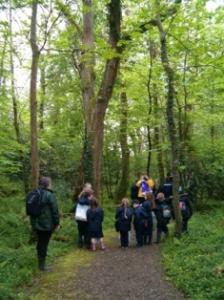
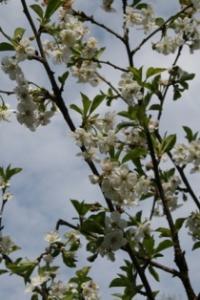
WildlifeAccess is provided at Ballyarr by a circular path which takes you through the oldest part of the woodland and shows the variety of habitats. The woodland is also being traditionally grazed during the winter months by small horses which eat the grasses, sedges and rushes and open up the ground to facilitate regeneration of the oak, hazel and holly. Ballyarr is a fantastic place to explore some of Ireland’s better known mammals. Evidence of badgers with huge sets and fox holes are to be found, deer visit the woodland occasionally and stoats make their homes in the old stone walls throughout the wood.The birdlife in Ballyarr is very diverse from the larger nesting Buzzards and Ravens to the noisy Jay and not to mention the wonderful chorus of the smaller woodland birds. |
FiadhúlraTá bealach isteach go Baile Áir ar chosán ciorclach a thugann tríd an bpáirt is sine den choill tú agus a léiríonn éagsúlacht na ngáthnóga.Cuirtear capaill bheaga ar féarach ar an mbealach traidisiúnta sa choill le linn mhíonna an gheimhridh. Itheann na capaill sin an féar, an chíb agus an luachair agus osclaíonn sé seo suas an talamh ionas go mbíonn na crainn darach, an cuileann agus an coll in ann athghiniúint.Is áit iontach í Baile Áir chun cuid de mhamaigh is coitianta in Éirinn a aimsiú. Tá lorg broc le brocaisí móra le feiceáil, chomh maith le poill sionnach. Tagann fianna isteach sa choill ó am go chéile agus déanann easóga a gcuid féin de na seanchlaíocha cloiche ar fud na coille.Tá éagsúlacht mhór éan i mBaile Áir, na Clamháin mhóra agus na Fiacha Dubha, chomh maith leis an scréachóg ghlórach agus cór álainn éin bheaga na coille.
|
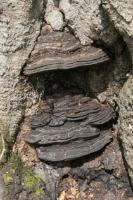
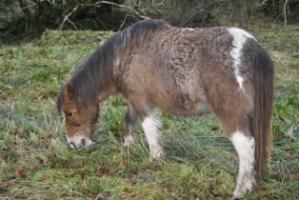
Derkmore Wood Nature Reserve
Longitude: -8.291
Duntally Wood Nature Reserve
Longitude: -7.901
|
Duntally wood is a National Nature reserve as well as a candidate Special Area of Conservation under the EU habitats Directive. Extending to over 15 hectares it is a fantastic example of an oak, ash, hazel woodland. Other notable tree species include Holly, Elm and Downy Birch. Ground flora is varied throughout the woodland and changes with soil and habitat type, common species include wood anemone, early purple orchid, hard fern, wild garlic, meadowsweet, bugle, and bluebell. |
Is Tearmann Dúlra Náisiúnta Coill Dhún a’tSáile chomh maith le bheith ina iarrthóir Limistéir Speisialta Caomhantais faoi Threoir Gnáthóga an Aontais Eorphaigh. Is sampla fíor mhaith í de thalamh coille darach, fuinseoige agus coil a chlúdaíonn cúig heicteár déag. I measc gnéithe eile crann tá cuileann, leamhán agus beith chlúmhrach. Ta fásra talaimh éagsúil ar fud an talaimh coille agus athraíonn sé de réir ithreach agus cineál gnathóige. I measc na gnéithe coitianta bíonn lus gaoithe, magairlín meidhreach, raithneach chrua, gairleog fhiáin, airgead luachra, glasair choille agus coinnle corra. |
BirdlifeBirdlife in the wood is very diverse from the colourful Jays to the agile Tree-creepers. Raven, Buzzard and Sparrowhawk all breed within or close to the woodland, while Wood pigeon and Blue and Long-tailed tits are regularly encountered on a walk. |
ÉanlaithTá éanlaith éagsúil sa choill ó scréachóga dáthúla go snaig lúfair. Póraíonn fiacha dubha, clamháin agus spioróga sa choill nó in aice láimhe. Buailtear le coilm coille, meantáin gorma agus meantáin earrfhada go rialta le linn siúlóide. |
The TrailA 2.5km loop trail takes you from the car-park along old cart-ways and down into the valley bottom. Potatoes and cereals were once grown in these meadows. Some have been cleared of tree cover to increase diversity within the woodland. |
An CasánTéann casán lúibe dhá chiliméadar go leith ar shean bhealaigh trucaile ón charrchlós síos go bun an ghleanna. Chuirtí prátaí agus arbhair uair amháin sna moinéir seo. Glanadh an clúdach crann de cuid díobh seo chun níos mó éagsulachta sa talamh coille a chothú. |
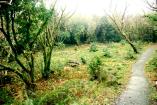
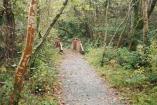
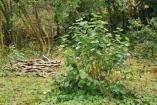
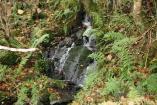
VisitingDuntally wood is a good place to explore some of our native mammal species. Deer visit the woodland occasionally during the winter months, while evidence of fox and badger can be found by their tracks and trails. Stoats and otters also frequent the woodland. Coppicing of the older stands of hazel trees is down by cutting the old tree down to almost ground level, far from the death of the tree this pruning actually increases the vigour of the tree while also changing light levels reaching the woodland floor. A quick growing species, hazel soon sends out new multi-stemmed growth. Historically these hazel wands were cut and used around local homes and farms as light timber for fencing and tool handles.Contact David McNamara on 087 6468412 National Parks & Wildlife Service Conservation Ranger, with any queries. |
Ar CuairtIs áit mhaith í Coill Dhún Tulaí chun eolas a fháil ar ghnéithe ár siní dúchasacha. Tugann carrianna cuairt ar an talamh coille ó am go ham i rith míonna an gheimhridh agus bíonn fianaise madaí rua agus broc le feiceáil ina rianta agus ina gcasán. Is cuairteoirí minice easóga agus dobharchúnna go dtí an talamh coille chomh maith. Déantar roschoill ar na seastáin chrann coil agus gearrtar síos iad go leibehéal an talaimh. Ní mharaíonn an roschoilliú seo iad ar chorr ar bith ach méadaíonn sé fuinneamh an chrainn agus athraíonn sé méid an tsoilais a shroicheann urlár an talaimh coille. Is gné crainn an coll a fhásann go gasta agus ní fada go gcuireann sé amach fás ilghasach. Sa tsean-am ghearrtaí na fleasca coill seo agus d’usáidtí iad thart ar thithe agus ar fheirmeacha áitiúla mar adhmad éadrom chun claíocha nó fálta a thógáil agus crainn nó cosa úirlise a dhéanamh.Teaghmháil David McNamara ar 087-6468412, Saoiste Caomhantais An tSeirbhís Páirceanna Náisiúnta agus Fiadhúlra. |
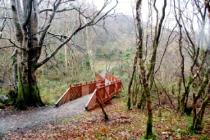
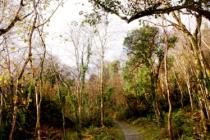
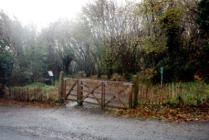
Inch Levels Wildfowl Reserve
Longitude: -7.443001
Inch Levels Wildfowl ReserveIreland’s premier wetland site, Inch Wildfowl Reserve is situated to the east of Lough Swilly, approximately 8 km to the south of Buncrana. It is an internationally significant destination and staging ground for migrating birds from three continents. This global importance is recognised by the area’s designation as a Special Protection Area (SPA) under the EU Birds Directive. The combination within this site of extensive feeding areas and safe resting and roosting sites makes this site one of the most important wetlands in the north-west of the country for wintering waterfowl. |
Anaclann Éanlaithe Fiáine Leibhéal na hInseTá príomhshuíomh bogaidh na hÉireann, Anaclann Éanlaithe na hInse, lonnaithe taobh thoir de Loch Suilí, tuairim is 8 km ó dheas de Bhun Cranncha. Is ceann scríbe suntasach idirnáisiúnta é agus talamh stad d’éin imirce as trí ilchríoch. Tugtar aitheantas dá thábhacht domhanda le hainmniú an limistéir mar Limistéar faoi Chosaint Speisialta (SPA) faoi Threoir maidir le hÉin ón Aontas Eorpach. Mar gheall ar an meascán de limistéir mhóra cothaithe agus de shuíomhanna sábháilte scíthe agus fara san áit seo, tá sé ar cheann de na suíomhanna bogaidh is tábhachtaí in iarthuaisceart na tíre d’éin uisce geimhrithe. |
HistoryInch Lough was created from the estuarine mud of Lough Swilly in the late 19th Century when two embankments were built to link Inch Island to the mainland on behalf of the Derry & Lough Swilly Railway. A railway embankment was then built dividing the area - the inner part (Inch Levels) being further drained to create polders or sloblands for agricultural use, while the outer part (Inch Lough) acted as a holding reservoir or lake for drainage water. A sluice gate in one of the original embankments allows drainage to the sea at low tide. There is some seepage of seawater back, creating brackish 'lagoonal' conditions within the lake. This large-scale engineering project transformed the area and has provided a resting stop for many travelling wildfowl, and is now an excellent place to spend your day. The lake is surrounded by marsh and swamp vegetation. The extensive sloblands to the east and south of the lake, Inch Levels, are included in the site. These lands are farmed intensively for grass, winter cereals and root crops and provide important feeding areas for wintering waterfowl, especially geese and swans. |
StairCruthaíodh Loch na hInse as láib inbhearach Loch Suilí ag deireadh an 19ú haois nuair a tógadh dhá chlaífort chun Oileán na hInse a nascadh leis an mórthír thar ceann Iarnród Dhoire & Loch Suilí. Tógadh claífort iarnróid ansin a roinn an limistéar – rinneadh tuilleadh draenála ar an gcuid istigh (Leibhéal na hInse) chun poldair agus slabaí a chruthú ar mhaithe le talmhaíocht, agus d’fheidhmigh an chuid amuigh (Loch na hInse) mar loch nó taiscumar coinneála d’uisce siltin. Ligtear d’uisce draenáil amach san fharraige, trí bhual-chomhla i gceann de na chéad chlaífoirt, nuair a bhíonn an taoide íseal. Sileann roinnt uisce sáile ar ais, rud a chruthaíonn coinníollacha ‘murlaigh’ sáile sa loch. D’athraigh an mórthionscadal innealtóireachta seo an limistéar ó bhun agus tá láthair scíthe cruthaithe do lear mór éan uisce géim agus iad ag taisteal. Is áit iontach anois í chun an lá a chaitheamh. Tá fásra seascainn agus réisce timpeall ar an loch ar fad anois. Tá na slabaí móra ar an taobh thoir agus ó dheas den loch, Leibhéal na hInse, san áireamh sa suíomh. Déantar dianfheirmeoireacht ar na tailte seo d’fhéar, do ghránbharra geimhridh agus do mheacain. Cuireann said limistéir thábhachtacha chothaithe ar fáil d’éin uisce geimhrithe freisin, go háirithe géanna agus ealaí. |
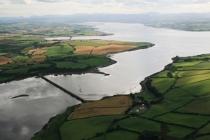
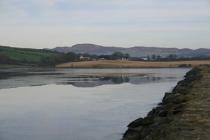
Excellent Bird WatchingWhether you are a serious twitcher or a novice bird watcher, the Inch Wildfowl Reserve provides excellent viewing opportunities for summer and winter visitors including wintering wildfowl and waders, not to mention the variety of summer breeders. It supports a wide diversity of wintering waterfowl, notably swans and geese, as well as breeding terns, gulls and duck. It is an important link in the overall Lough Swilly wetland system, which includes Blanket Nook and Big Isle to the south. Three of these species occur in nationally important numbers (Greenland White-fronted Goose, Sandwich Tern and Common Tern) and one of these in internationally important numbers (Whooper Swan). In addition, it also supports internationally important numbers of the migratory species Greylag Goose. Two species, Whooper Swan and Greylag Goose, occur in numbers of international importance. Greylag geese numbers fluctuate depending on the weather (2008 numbers peaked at 3000+). Considerably higher numbers of Whooper Swan (peak of 6000+) have been recorded, especially early in the season, as this is the area where the swans make their Irish landfall in autumn on their return from breeding grounds inIceland. |
Fairtheoireacht Éan den ScothBíodh tú i d’fhaireoir éan fánach nó dáiríre, cuireann Anaclann Éanlaithe Fiáine na hInse deiseanna iontacha féachana ar fáil do chuairteoirí samhraidh agus geimhridh, lena n-áirítear lapairí agus fia-éin gheimhrithe, gan trácht ar na cineálacha difriúla póraitheoirí samhraidh. Tacaítear le héagsúlacht mhór éan uisce geimhrithe, go háirithe ealaí agus géanna, chomh maith le geabhróga goir, faoileáin ghoir agus lachain ghoir. Is nasc tábhachtach é i gcóras iomlán bogaidh Loch Suilí, a bhfuil Cúil na Birte agus an tOileán Mór ó dheas san áireamh ann. Tá tábhacht náisiúnta ag baint leis an lion de thrí cinn de na speicis seo atá ann (an Ghé Bhánéadanach Ghraonlannach, an Gheabhróg Scothdhubh agus an Gheabhróg). Tá ceann de na speicis ann i líonta atá tábhachtach go hidirnáisiúnta (an Eala Ghlórach). Chomh maith leis sin, tacaíonn an áit le líon tábhachtach idirnáisiúnta den speiceas imirce, an Ghé Ghlas. Tá tábhacht idirnáisiúnta leis an lion de dhá speiceas atá ann, an Eala Ghlórach agus an Ghé Ghlas. Téann líon na ngéanna glasa suas agus síos ag brath ar an aimsir (d’ardaigh lion na ngéanna go 3000+ sa bhliain 2008). Tá cuntas oifigiúil tógtha de líon i bhfad níos mó ná sin d’Ealaí Glóracha (uasmhéid de 6000+), go háirithe luath sa séasúr, ó tharla gur sa limistéar seo a thagann na healaí ar an talamh in Éirinn san fhómhar agus iad ag filleadh óna gcuid tailte pórúcháin san Íoslainn.
|
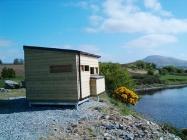
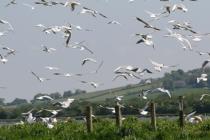
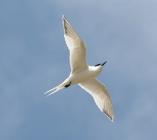
Beautiful WalksIf you want to get away from the hustle and bustle of everyday life, you can take advantage of over 8km of idyllic country walks, whilst taking in the majesty of the Inishowen Peninsula. There are also designated picnic areas to take time out to relax, refresh and renew. For further information contact National Parks and Wildlife Service, Glenveagh National Park, Churchill, Letterkenny, Co. Donegal. |
Siúlóidí ÁilleDá mba mhaith leat éalú ó anó an tsaoil, is fiú leas a bhaint as breis agus 8km de bhealaí siúlóide a thugann léargas duit ar áilleacht Leithinis Inis Eoghain. Tá láithreacha picnicí ar leith ann freisin chun deis a thabhairt duit do scíth a ligean. Chun tuilleadh eolais a fháil, téigh i dteagmháil leis an tSeirbhís Páirceanna Náisiúnta agus Fiadhúlra, Páirc Náisiúnta Ghleann Bheatha, Mín an Lábáin, Leitir Ceannain, Co. Dhún na nGall. |
Inch Woodland Education AreaThe Inch Woodland Education Area is the ideal place for school visits with a range of curriculum-based learning tools for primary and post-primary level groups. The education area caters for groups from junior and senior infants, and has tailored programmes for children from 1st and 6th class. There is also a picnic and interpretative area for families and small groups. To access the education and field trip investigation sheets visit below. |
Limistéar Oideachais Choill na hInseIs iontach an áit é Limistéar Oideachais Choill na hInse do chuairteanna ó ghrúpa daltaí bunscoile agus meánscoile mar go bhfuil réimse uirlisí foghlama atá bunaithe ar an gcuraclam ann. Déanann an limistéar oideachais freastal ar ghrúpaí ó na naíonáin bheaga agus na naíonáin mhóra agus tá cláir ar leith ann do pháistí ó rang a haon go dtí rang a sé. Tá láthair phicnicí agus léirmhíniúcháin ann freisin do theaghlaigh agus do ghrúpaí beaga. Chun teacht ar na bileoga fiosrúcháin oideachais agus turais taobh amuigh, téigh chuig thíos. |
Lough Barra Bog Nature Reserve
Longitude: -8.115
Meenachullion Nature Reserve
Longitude: -8.121
Pettigo Plateau Nature Reserve
Longitude: -7.942
| Pettigo Plateau Nature Reserve is located on the western shores of Lough Derg located some 10km south east of Donegal Town. The site was designated as a Nature Reserve in 1984 to protect 900 hectares of blanket bog and wet heath. It is one of the few remaining extensive intact bogs in Co. Donegal and the quality of habitat has led to its designation as a Special Area of Conservation and as a Special Protection Area for its birdlife. These sites form part of Natura 2000 which is a network of the most important conservation areas in Europe. The site comprises a mosaic of active blanket bog, lakes and wet heaths and is largely undisturbed. The flora includes cowberry and cranberry and a rich variety of bog mosses amongst the interlocking bog pools. The rare white sedge has also been recorded at this site. Irish hare, badger, otter and common frog are found within the site and are all listed as internationally important in the Irish Red Data Book. The Common Lizard is present within the site and can often be found basking on rocks during sunny days. | 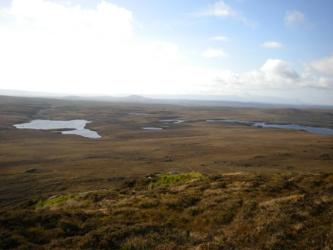 |
Birds of PettigoThe plateau provides good hunting habitat for Merlin and Hen Harrier which can be seen at the reserve. Surrounding forestry supplies suitable nesting habitat for these species. During the spring and summer the soft mournful whistle of the Golden Plover can be heard on the higher grounds of Croaghadalough. These birds breed on the upper slopes of the reserve and will alarm call if disturbed by walkers. In the winter these birds form much larger flocks as they are joined by wintering birds from Iceland and the Faroes. One of the most enticing things about the reserve is its very isolation and feeling of remoteness. Though uninhabited today this area was formerly part of the Leslie Estate and in the mid-1800s was occupied by two families. The remains of their small cottages and cultivation plots can still be seen in the reserve today. An old trackway runs through the reserve providing visitor access. |
|
Rathmullen Wood Nature Reserve
Longitude: -7.563
| Rathmullen Wood is national Nature Reserve as well as a candidate Special Area of Conservation under the EU Habitats Directive. Extending to over 33ha it is a fantastic example of an old oak woodland. The other main tree species are holly, hazel and downy birch. However, on first entering the woodland you are struck by the extent and individual size of the beech trees. Considered a non-native species this beech plantation does not support the biodiversity that the rest of the woodland contains. Ground flora is varied throughout the woodland and changes with soil and habitat type, common species include woodrush, bilberry, hard fern, wild garlic, bugle and bluebell. | Is Tearmann Dúlra Náisúnta Coill Ráth Maoláin. Is iarrthóir Limistéir Speisialta Caomhantais faoi Threoir Gnáthóga an Aontais Eorpaigh í chombh maith. Is sampla den chéad scoth í de thalamh coille darach a chlúdaíonn 3 heeicteár agus 30. Is iad cuileann, coll agus beith chlúmhrach na trí chineál crann eile ann. Cibé ar bith ar do dhul isteach sa talamh coille seo téann airde agus fairsinge na bhfáibhilí ina luí ort. Tuigtear nach gné dúchasach an fháschoill fháibhilllí seo agus ní chothaíonn sí an bithéagsúlacht atá ar fail sa chuid eile den talamh coille. Ta fásra talaimh éagsúil ar fud an talaimh coille agus athraíonn sé de réir ithreach agus cineál gnathóige. I measc na gnéithe coitianta tá luachra coille, fraochán, raithneach chrua, gairleog fhiáin, glasair choille agus coinnle corra. |
BirdlifeBirdlife in the wood is very diverse from the colourful Jays to the agile Treecreepers. Raven, Buzzard and Sparrowhawk all breed within or close to the woodland, while Wood Pigeon and Blue and Long-tailed Tits are regularly encountered on a walk. |
ÉanlaithTá éanlaith éagsúil sa choill ó scréachóga dáthúla go snaig lúfair. Póraíonn fiacha dubha, clamháin agus spioróga sa choill nó in aice láimhe. Buailtear le coilm coille, meantáin gorma agus meantáin earrfhada go rialta le linn siúlóide. |
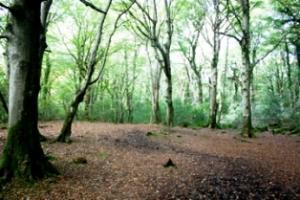 |
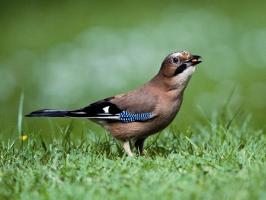 |
The TrailA 1km loop trail takes you from the carpark through a section of the Beech plantation and through areas of mixed native woodland. |
An CasánTá casán lúibe ciliméadar ón charr-chlós trí chuid den fháschoill fhábhilí agus trí thalamh coille measctha dúchasach. |
| Visiting Rathmullen Wood is a good place to explore some of our native mammal species. Deer visit the woodland occasionally during the winter months, while evidence of fox and badger can be found by their tracks and trails. Regeneration of the beech trees outside of the main plantation is managed through selective removal and ring-barking. A quick growing species, beech soon out competes oak for light and space thereby probably becoming the dominant tree species over time. Contact David McNamara on 087 6468412 National Parks & Wildlife Service Conservation Ranger, with any queries. |
Ar Cuairt Is áit mhaith í Coill Ráth Maoláin chun eolas a fháil ar ghnéithe ár siní dúchasacha. Tugann carrianna cuairt ar an talamh coille ó am go ham i rith míonna an gheimhridh agus bíonn fianaise madaí rua agus broc le feiceáil ina rianta agus ina gcasán. Coinnítear cosc ar athnuachán na bhfáibhillí taobh amuigh den phríomh-fhaschoill trí iad a bhaint amach nó trí fheannadh fáinne. Is gné crainn a fhásann go gasta an fáibhile agus coinníonn sí solas agus spas ón dair agus dá bharr is í an gné crainn is treise in áit i ndiaidh tamaill. Teaghmháil David McNamara ar 087-6468412, Saoiste Caomhantais An tSeirbhís Páirceanna Náisiúnta agus Fiadhúlra. |
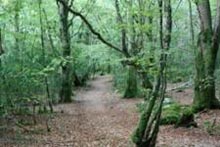
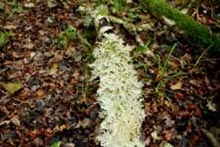
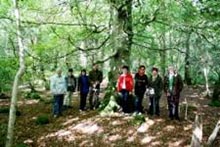
Sheskinmore Nature Reserve
Longitude: -8.463635
| Sheskinmore refers to a large area of sand dunes, lake and marsh that lies between Kiltooris and Ballinreavy Strand, north west of Ardara, Co. Donegal. The area is designated as a Special Area of Conservation (SAC), a Special Protection Area (SPA) and a Wildfowl Sanctuary. The area is easily accessed from the gate at Mullyvea opposite Kiltooris Lough. | Is ceantar mór dumcha, locha agus seascainn é Seascann Mór atá idir Cill Dorais agus Trá Bhaile an Riabhaigh ar thaobh thiar thuaidh d’Ard Ratha, Co. Dhún na nGall. Tá an ceantar ainmnithe mar Cheantar Speisialta Caomhnaithe (SAC), mar Cheantar Cosanta Speisialta (SPA) agus mar Thearmann Éanlaithe. Tá sé furasta dul isteach ann tríd an geata ag Mullach Bheitheach os coinne Loch Chill Dorais. |
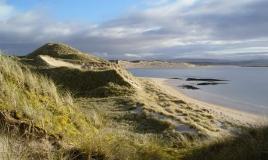
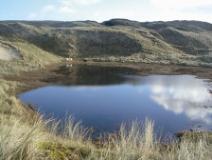
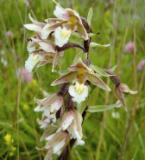
HabitatsThe area is mostly a fixed sand dune system, which includes machair grassland, dune slacks, Sheskinmore lough and the surrounding marsh, fen and reedbed. There is some oak and hazel scrub with heath on the drier northern slopes behind the lough and there is also coastal heath on the Carrickalagh headland. Sescenn Mór literally means “big marsh” and the marshy plain contains much of the areas’ interesting flora and fauna. South and west of the flat marshy plain there are sandy machair grasslands which evolve into high undulating sand dunes along Trawmore Strand and Ballinreavy Strand. |
GnáthógaIs córas duimhche seasta an ceantar seo den chuid is mó ina bhfuil talamh féarach, machaire, dumhcha, Loch an tSeascainn Mhóir, machaire moing agus sraith ghiolcach thart air. Tá crainn dharach agus scrobarnach coil maraoin le fraoch ar na fánaí tirime ar an taobh thuaidh den loch agus tá fraoch cósta ar cheann tire Charraig Adhlactha. Ciallaíonn Seascann Mór bogach nó corrach mór agus ta fásra agus ainmhíthe suimiúla le fail ar chuid mhaith den mhachaire corrach seo. Ar an taobh theas agus thiar den mhachaire tá talaimh féir gainimh a éiríonn ansin i ndumhcha droimnigh arda le taobh trá na Trá Móire agus Trá Bhaile an Riabhaigh |
BirdsA visit at any time of year is always interesting for birdlife. During the winter a small flock of Greensland White Fronted Geese feed undisturbed here. Chough and Twite also feed here in Winter. Brent Goose, Whooper Swan, Wigeon, Tufted Duck, Goldeneye and Golden Plover are other winter visitors. Lapwing, Mallard, Teal, Snipe and Mute Swan are found all year round as are Linnet, Skylark, Meadow pipit, Stonechat and Reed Bunting. Summer visitors include the Grasshopper, Sedge and Willow Warblers and Wheatear, Swallow and Cuckoo. Birds of prey species use this vast open undisturbed site to hunt. |
Ein Is fiú go mór cuairt a thabhairt anseo ag am ar bith den bhliain chun an éanlaith shuimiúil a fheiceáil. I rith an gheimhridgh bíonn scata Géanna le Brollaigh Bhána ón Ghraonlainn a chothú ann. Bionn an Cág Deargchosach agus an Ghleoiseach Shléibhe ann as gheimhreadh. Is cuairteoirí geimhridgh eile iad an Ghé Dhubh, an Eala Ghlórach, an Lacha rua, an Lacha Dhubh, an Feadóg Shléibhe agus Feadóg na Súile Óire. Chítear an Pilibín, an Mallard, an Phraslacha, an Naoscach, an Eala Bhalbh ann I rith nab liana chomh maith leis an Ghleoiseach, an Fhuiseog, an Riabhógmhóna, an Chloch Dearg agus an Ghealóg Dhúcheannach. I rith an tsamhraidh bionn an Dreoilin Teaspaigh, an Chíb, an Ceolaire Sailí, an Chlochrán, an Fhainleog agus an Chuach le feiceáil ann. Úsáideann éin chreiche an láithreán leathan oscaillte seo mar thalamh seilge. |
| Plants The fixed dune and machair are managed to enhance their species richness. Cattle graze extensively during the winter months only. Orchid species include the Marsh Helleborine, Bee Orchid, Frog Orchid and the rare Irish Orchid. There is a succession of colour throughout the summer months in the dunes and on the marsh, from yellows and whites in spring through to the pinks and purples of the late summer. Rarieties recorded in the area include the aquatic slender naiad and pipewort, the tiny petalwort, also quillwort, hoary whitlow grass and many stonewort species. |
Plandaí Riaraítear na dumhcha seasta agus an machaire chun siabhreas na ngnéithe a mhéadu. Bíonn eallach ag iníorgo tréan anseo i rith míonna an gheimhridh amháin. I measc an ngnéithe magairlíne tá Cuacihín Corraigh, Magairlín na mBeach, Magairlín an Ioscáin agus Magairlín Éireannach atá neamhchoitianta. Bíonn athraithe datha trí mhíonna an t-samhraidh sna dumhcha agus ar an machaire ó dhath buí agus bán an earraigh go dathanna bándearga agus corcra dheireadh an t-samhraidh. I measc na ngnéithe neamhchoitianta a rinneadh cuntas orthu sa cheantar seo tá nimfigh uisce, píbín uisce, tursarraing chleite, bosán anagair agus tursarraing chloiche. |
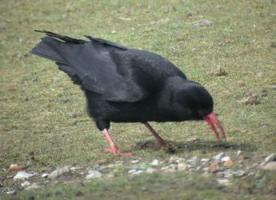 |
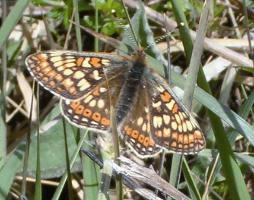 |
AnimalsRabbits, badgers and foxes are the most common mammals recorded at Sheskinmore. Otter have been seen in the lough. Frog and newt breed in and around the dune slacks and the common lizard breeds on the drier slopes. The protected tiny marsh snail speciesVertigo geyeri is found in the fen habitat west of the lough. The area is also noteworthy for the variety of butterflies and dragonflies that breed here. Marsh fritillary and dingy skipper both breed at Sheskinmore along with 18 other butterfly species. Sheskinmore lough and associated wetlands is the most species rich site in Donegal for dragonflies and damselflies. Fifteen species have been recorded, the most interesting being the Black-tailed Skimmer and the small Blue tip. |
2
AinmhitheIs iad coiníní, broic agus sionnaigh na siní is coitianta ar an t-Seascann Mór. Chonacthas dobharchúnna sa loch. Bíonn an frog agus an t-earc luachra ag síolrú thart ar na dumhcha agus an t-earc coitianta ag síolrú ar na fánaí tirime. Faightear seilidí beaga corraigh. Vertigo geyeri atá cosanta sa ghnáthóg moinge taobh thiar den loch.Tá cáil ar an cheantar seo as ucht ilghnéitheachta na bhfeileacán agus na snatháidí móra a shíolraíonn anseo. Bíonn Fritileáin corraigh agus Preabairí modartha ag síolrú ar an SEascann Mór maraon le ocht ngné déag d’fheileacán. Bíonn níos mó gnéithe de shnatháidí móra agus cuileoga daimsil le fail I gceantar Loch an t-Seascainn Mhóir agus na talaimh fliucha thart air ná in áit ar bith eile i gCo. Dhún na nGall. Rinneadh cuntas oifigiúil ar cúig ghné déag díobh agus Snatháid an Eireaball Dhuibh agus Snatháid Bheag an Bhairr Ghoirm ar na cinn is suimiúla. |
ManagementThe property is managed by NPWS to maximise its biodiversity. The area is rich in marsh and dune plants and supports a wide variety of invertebrates and birds. The cereal plot at the Mullyvea entrance was first planted in 2004 to feed finches and buntings during the winter months. Another plot is planned for Sandfield. The site is winter grazed to encourage floral diversity and cow pats are also a source of food for foraging chough. Stocking rates are periodically reviewed and horses may at times be grazed on the site. Various methods have been tried to control bracken. A sluice is in place to control water levels at the lough in order to protect the slender naiad population. In 2007 McGlinchey’s house at Sandfield was fully restored and is now used as a field studies centre. |
BainistíochtRiaraíonn an NPWS an eastát se chun uasmhéid éagsúlacht bheatha a fháil. Is ceantar saibhir é le plandaí seascainn agus dumhcha a chothaíonn éagsúlacht leathan éan agus ainmhíthe gan cnámh droma. Cuireadh arbhar don chéad uair I 2004 ag bealach insteach ag Mullach Bheitheach chun na gealóga a bheathú i rith an gheimhridh.Tá plean do phlota eile arbhair ag Achadh an Ghainimh. Cuirtear eallach ag iníor ar an láitrhreán sa gheimhreadh chun cuidiú leis an éagsúlacht bláthanna agus is foinse bia an cac bó do na cáig dhearg-chosacha. Coinnítear súil ar an stoc ó am go ham agus b’fheider go ligtar do chapaill a bheith ar fhéar anseo chomh maith. Úsáideadh dóigheanna éagsúla chun smacht a chur ar an raithneach. Cuireadh loc-chomhla ann chun leibhéil an uisce a chosaint. I 2007 coíríodh Teach Mhic Loinsigh in Achadh an Ghainimh agus tá sé in úsáid mar ionad staidéir amuigh faoin aer. |
Access & SafetyThere are three signed access points. The main entrance is at the Mullyvea gate opposite Kiltooris Lough. There is access from the east side at both Murveagh and Sandfield of the R261. Walkers should be cautious of grazing animals between October and May and dogs should be kept on a lead and under control at all times. Some of the land within the site is still privately owned so be careful to close gates and not to damage walls or fences. Appropriate walking clothing and a map and compass are recommended. Any damaging activities should be reported to NPWS at Gleanveagh National Park 074 -9137090 or NPWS at Ballinafad, Co. Sligo, 071 9666700 |
Bealach Isteach agus SábháilteachtTá trí bhealach isteach le comharthaí. Tá an príomhbhealach isteach ag geata an Mhullaigh Bheitheach os coinne Loch Chill Dorais. Tá bealach isteach ón taobh thoir ag Muirbheitheach Bheitheach agus Achadh an Ghainimh ón R261. Ba choir do shiúlóirí o bheith cúramach roimh ainmhíthe ar fhéar ó Dheireadh Fómhair go Bealtaine agus ba cheart madaí a choinneáil ar éill agus faoi smacht an t-am uilig. Ná dean dearmad na geataí a dhruid ná dochar a dhéanamh do bhallaí agus do fhálta.Moltar do shiúlóirí éadai foirstineacha a chaítheamh agus léarscáil agus compass a thabhairt leo. Má bhíonn imeachtaí a chuisíonn dochar ba choir fios a chur ar an tSeirbhís Páirceanna Náisiúnta agus Fiadhúlra I nGleann Bheitheach 074-9137090 nó ag Baile an Atha Fada, Co. Shligigh 071- 9666700 |
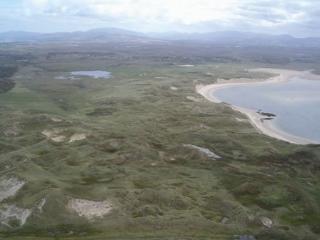 |
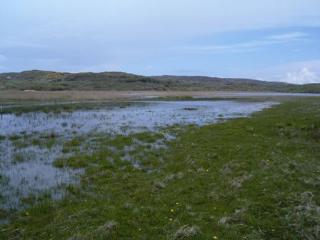 |

